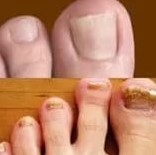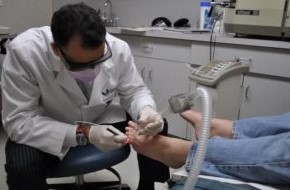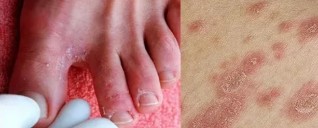Fungal infection on the toenails is now widely accepted. There are different kinds of nail fungus on the feet, and treatment is directly dependent on the type of pathogen. The cause of the disease is not a lack of hygiene, but in the fact that many are forced to during the whole working day to be in the shoes.

The essence of the infection and the development of the disease is in the contact of the fungal spores with the skin of the feet. Microorganisms penetrate in the various cracks, bumps, unevenness, damage. In almost all cases the fungus passes on the nails, which immediately begin to raise an unhealthy appearance.
The basic types of
Itching, change in the nail plate – are the most common symptoms of the disease, which, in all its forms. There are more specific symptoms depending on the type of pathogen. So, what kinds of mold are there?
Dermatophyte
This form develops when they come into contact with representatives of the Trichophyton, Microsporum and Epidermophyton.
A person is faced with the following symptoms:
- the emergence of gray, yellow stripes on the plates. The first spots appear on one nail, gradually transition to the adjacent;
- the nail gradually starts to lag behind the bed.
Forms
Mold able to hit not only products, but also the skin and nails of man. The main symptom of this form of fungal disease is change the color.
From a healthy pink color will become unpleasant black, brown or green. Not less frequent symptom is the occurrence of black dots, spots.

Yeast
Appear due to infection by the fungus Candida. Negative qualities is a great probability of total defeat of the stop. The main symptoms include:
- The surface of the nails becomes much thinner, so the faster break down.
- The nail plate is different in color and in texture.
- With the development of the disease are observed with strong scrub away with.
- Your fingers are constantly swollen, gaining a red color.
This infection spreads moisture. Just for this reason, it is important to follow certain preventive measures when visiting swimming pools, spas, public showers.
Classification in the development stage
To assign the most effective treatment, the doctor should determine what degree of development reached of the disease, i.e., to correctly determine the stage of the fungus on the feet. With the development of the infection pathology is beginning to spread not only in the vicinity of the is located the nails, but also on the skin, it affects the whole foot.

Forms of the disease based on the stage of its development:
- Normotroficheskie, at which the observed color change of the nails, appear stripes, but the form is changing. It is in the initial stage of the infection.
- Hypertrophic, changing the already nail. It is very easy to breaks down, becomes thin, and thus brings the patient a huge inconvenience.
- Atrophic. The board in this case becomes much thinner, it's grayed out, changing the shape, the nail bends and quickly collapses. In this stage, the plate, the fungus starts to move from the bed. The treatment here is quite difficult, as the disease begins to take a running form.
The appropriate therapy
Get rid of the disease is possible only with the help of proper therapy. It depends on the type of mold and will necessarily rely on the stage of the disease.
The doctor performs a medical expert examination, determines the shape and appearance of the mold, examining the individual characteristics of the organism and prescribe treatment.
The selection of the schema
Medicine offers three basic scheme of treatment – systemic, comprehensive, and therapy external means. In the first case, it is assumed the use of drugs in the form of tablets or capsules. Many of them have a large number of side effects.
In the complex therapy, the treatment is prescribed not only medication, but also local drugs. When the outer celebrates a minimal amount of side effects because this system is more suitable.
An important point is the external treatment – it helps not only in the initial stage of the disease, i.e. if it is beaten, less than one-third of the nail plate and no more than two fingers.

During the treatment of virtually all stages and in all forms are assigned different plan outside of treatment. These are creams, happiness and solutions. Varnishes have effect only on the nail fungus on the feet, without affecting nearby is the fabric.
Among the external means of treatment are often used various creams. Not only does it effectively remove all the pathological symptoms, but also soften and moisturize the nails, reduces the indicators of discomfort. Outside depending on the chosen method of treatment of mould and of the drug, it is very important to follow the instructions of the expert and yourself drugs. Just so it is possible to achieve the maximum positive result of the treatment. Just the cure for the treatment will provide the antifungal effects and the optimal antibacterial effect.
The number of applications and techniques depends from the drug, but also on the type of mold and mold its development. Usually, this two–three times a day.
If they use external means of treatment mold, before each application, it is worth it to take pictures with the help of special tools Horny land. This will strengthen the soulful ability of the drug, it will help much faster to achieve a positive effect, regardless of the type of mold.
To sum up
The total length of therapy of mold in the diameter of 6 months, only after there has been an increase in healthy, rejuvenated nail plate. To achieve a similar outcome of the treatment usually does not stop, it is necessary to continue until then, until it is reached a stable effect and cannot be completely prevented recurrence of the disease.





























